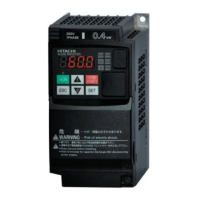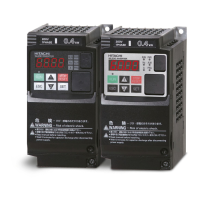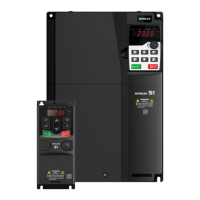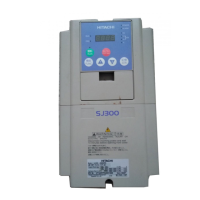Chapter 8 Mandatory Setting for Motor Drive and Test Run
8-1-13
8.1.5 Setting Motor Constant
How to solve the unstable drive of the motor?
How to use a Hitachi standard induction motor?
How to set the motor constants required for automatic torque boost function and sensorless
vector control?
When the automatic torque boost function or sensorless vector control is used with an induction
motor, the motor constant must be set according to the motor to be used. There are three ways
to set the motor constant.
(1) Using Hitachi standard motor.
When using a Hitachi standard motor, set "Async. Motor constant selection [H002]
*1
"
to "Hitachi Standard (00)". When the IM motor capacity or the number of IM motor
poles is changed, the motor constant parameters in the table below are
automatically changed to Hitachi standard motor constants.
(2) Measuring by the auto-tuning function.
This function measures the motor constant when using a motor whose motor
constant is unknown, etc. Even when using a Hitachi standard motor, it may be
better to perform auto-tuning if the load inertia is large or the wiring length is long.
For details, refer to "8.3 Carrying Out Motor Auto-tuning".
(3) Setting the motor constants arbitrarily.
Values obtained from motor manufacturers, etc. can be directly set to the
parameters in the table below. Or, after (1) or (2), change the parameters in the table
below for fine adjustment.
Hitachi standard motor constant setting values in the table below are data for one phase of Y-
connection motor converted to 200 V/400 V 50 Hz input.
Motor constant parameters in the table below can also be adjusted and changed manually.
However, note that if the motor capacity or number of motor poles is changed, it will be
changed to Hitachi Standard Motor constant.
If you have a remote operator (WOP), back up of the motor constants with Read/Write function
is recommended.
When using a motor whose motor constants are unknown, ask the motor manufacturer for the
motor constants or measure the motor constants using the auto-tuning function. For details,
refer to "8.3 Carrying Out Motor Auto-tuning".
For adjustment when sufficient characteristics cannot be obtained in the case of automatic
torque boost function or sensorless vector control, see "9.5.3 Using Torque Boost Function" or
"9.5.7 Driving with Sensorless Vector Control".

